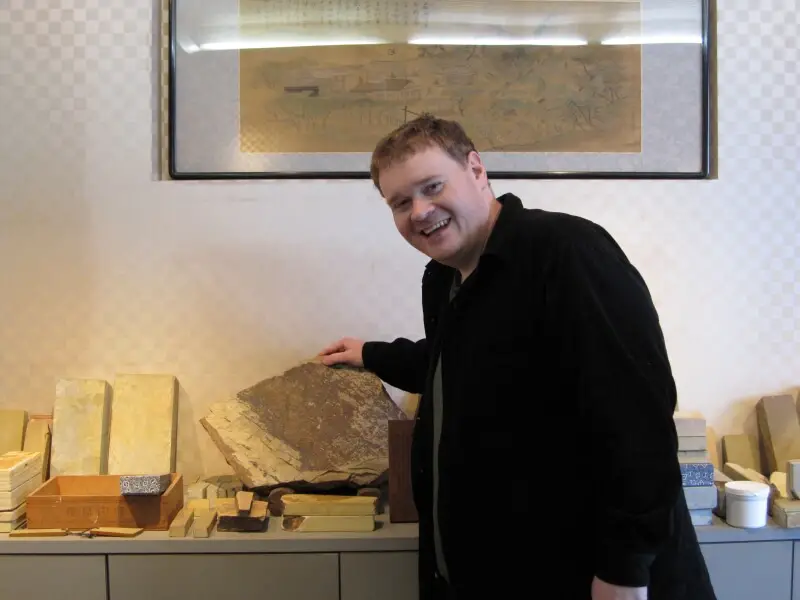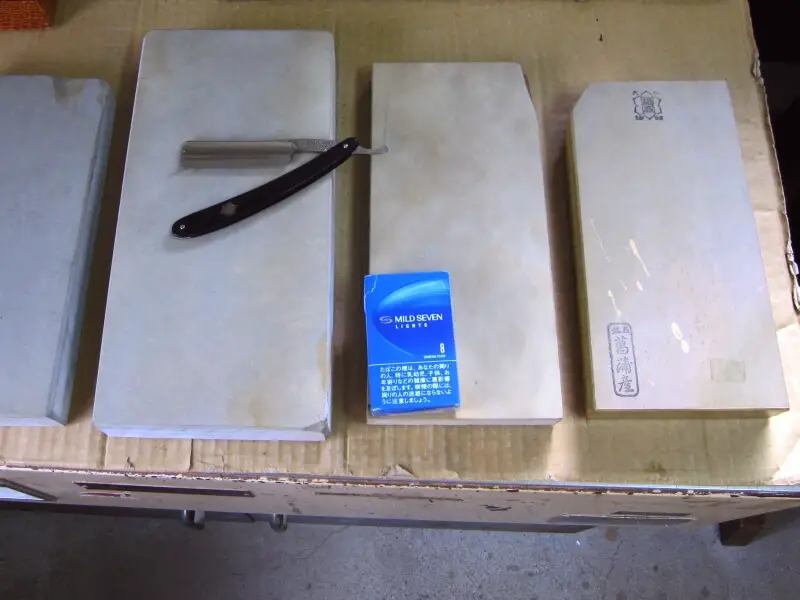
I’d like to take a couple of articles to talk about one of my favorite topics, Japanese natural whestones, or Tennen Toishi. The subject is very deep, so I’ll have to skip a lot, but I’d like to talk about the history of these stones, their different qualities and attractions, and hopefully dispel some of the mystery surrounding them. For more information, you can always check out my blog, Eastern Smooth.
Why whetstones on a Shaving Site?
One of the most important things to know for those thinking about taking up straight shaving is, those blades don’t sharpen themselves. Average use (or misuse) leads to the deterioration of your edge over time, to the point that stropping on leather no longer leads to a comfortable shave. The most common way of fixing that is a whetstone. For some, this is a bit of a turnoff as it does require a certain level of skill and practice to produce a good shaving edge, but for others (myself included) that’s part of the allure of straight shaving: the feeling you get when you successfully put a smooth, sharp edge on a razor is amazing.
There are many, many stones used to sharpen razors. The most common are artificial ceramic or resin-based stones, but for the true traditionalist (read: romantic), natural stones hold a lot of charm. Long before people started manufacturing whetstones to sharpen their blades, they used natural rocks dug right out of the ground to do so, and the very best and finest of these were used to sharpen razors.
Razors have extremely thin blades, and due to their intended use they must have the smoothest, finest edge possible. Both of these facts mean that stones normally used for common blades like knives or axes simply won’t cut it (pun most certainly intended), and so the best stones, with the most uniform texture and the smallest possible particles, were used for razors. These stones are almost unusable for most heavy blades, they are a straight shaver’s dream.
There are mines and quarries that have produced stones for razors all over the world. In Europe, Belgian Coticules and German Thuringian stones are well known for razor use, and in the US “Translucent” or “Surgical Black” Arkansas stones are sometimes used for razors. But for a growing number of straight razor users and sharpeners, the ultimate razor stones come from Japan.
Japanese Whetstones through History
I’ve talked about Japanese blades here before, but to a master smith the stone used to put an edge on his blade is as important as the blade itself. Kousuke Iwasaki, founder of Iwasaki Seisakushou and the father of current master smith and razor maker Shigeyoshi Iwasaki, went so far as to search out and reopen a long-dormant mine to produce the stones he felt matched his razors. In addition, a very large stone, with all the necessary properties for a good razor hone, and an attractive pattern, can cost several thousand dollars. Japanese whetstones are serious stuff.
The best Japanese hones come from the area around Kyoto city, the old capital of Japan. On the northern edge, in the area called “Narutaki,” is a mountain called Atagoyama. Clustered around this mountain, spreading to the east, are a number of smaller mountains riddled with rock mines and quarries: these are the source of all of the most popular finishing whetstones, and those most often used to sharpen razors here in Japan. The most famous source of fine Japanese stones is a place called “Nakayama.” This area of Atagoyama has several mines, and all of them have developed a reputation, deserved or not I can’t really say, of being the very best stones available. There are many other mines nearby: Oozuku, Oohira, Shoubudani, Osaki, the list goes on and on. All of these are known collectively as “Eastern” mines, and all of them produced razor quality stones.

The history of these mines goes back more than 800 years, when the first Nakayama mine was opened on land owned by a Buddhist temple. The stones quickly gained the attention of the local lords, as whetstones were not only useful in military roles, but also in the vital work of carpenters building castles and temples. Since Kyoto was the home of the emperor, who had a vital role in the Shinto religion of Japan, it and the nearby city of Nara, are filled with beautiful temples and shrines, each of which required the most skilled craftsmen working with the best tools to build and maintain. Whetstones were a constant necessity, then, for these workers.
Indeed, Japanese carpentry is where these stones really show their worth, as the incredibly precise and detailed work of Japanese Temple carpenters (Miya-daiku) requires blades that are every bit as sharp and smooth as a razor, but much thicker. To this day, whenever you are looking for a good stone in Japan, the first place to go is to a shop selling woodworking tools, as these will usually have the best selection of natural whetstones.

Carpenters still make up the bulk of Japanese natural whetstone customers. There are even competitions testing a carpenter’s sharpening skill, where they will each take turns using planes they have sharpened themselves, and see who can shave the thinnest continuous piece of wood. The results are beautiful, translucent pieces of wood as thin and flexible as tissue paper, only a couple of microns thick. That’s the result of a heavy plane blade sharpened, with considerable skill, on a natural Japanese whetstone. On a razor, the edge is even more refined, and it really is worth experiencing.
For most of Japanese history, shaving was not a popular activity. When razors from China (via Korea) first appeared in Japan, they were solely used to shave Monks’ heads. It wasn’t until the mid- to late-Edo period, roughly around 1750 or so, that shaving gained popularity with the Samurai. When barbers began using and sharpening razors to shave the faces of well armed and rather touchy nobility, they needed the best edges possible…and so they used these same stones to sharpen their razors. Nowadays, despite the near universal use of disposable-blade Feather Artist Club style razors, barbers are still trained to sharpen razors on these stones, and often are a good place to look for old, high-quality stones. My barber, in fact, is the one who got me started on this path with a gift of stones and razors.
That concludes the first part of this series. Next time, I’ll talk about these stones in more detail, including information on the various names and words we use when talking about these stones. Thanks for reading!
